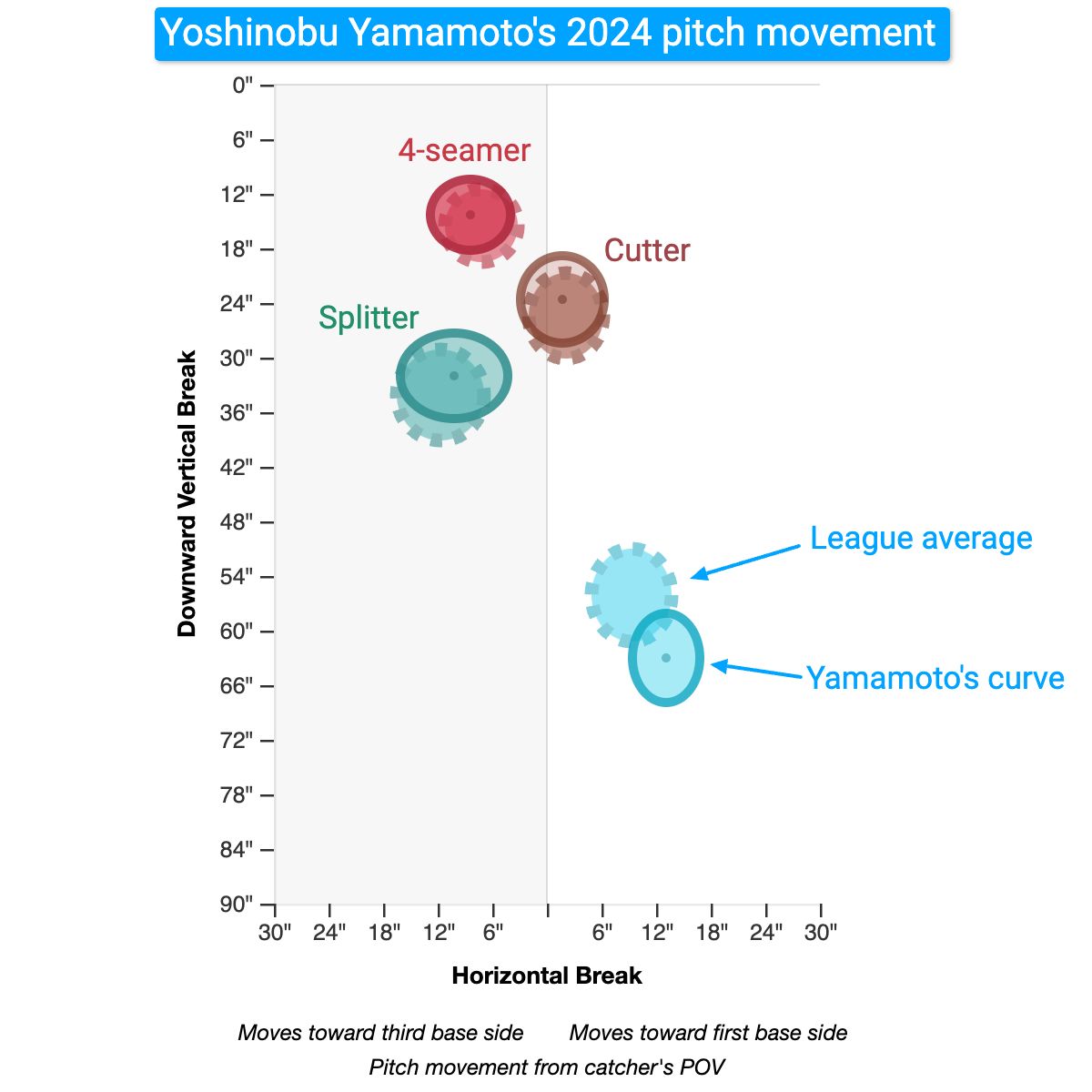Yoshinobu Yamamoto's yo-yo curveball has arrived.
We knew coming into Yamamoto's first season with the Dodgers that the curve was his signature pitch. We got a preview of how good that curveball could be in the World Baseball Classic and hoped Yamamoto could follow in the footsteps of longtime Dodgers ace Clayton Kershaw and his iconic curveball, Public Enemy No. 1. But now we can see his stuff side-by-side next to other big league pitchers for the first time.
And what we're seeing is: Yamamoto's curveball already looks like one of the best in MLB.
Even in Yamamoto's rocky first outing in Korea, the pure stuff was there. Then, in his Dodger Stadium debut, the results came through. Yamamoto's curveball was Public Enemy No. 2.
Yamamoto totaled 10 called and swinging strikes with his curveball against the Cardinals, making him one of four starters to reach double digits in a game this year. (Orioles ace Corbin Burnes has the most, with 13 on Opening Day.)
Here's what those Yamamoto curveballs looked like from the batter's box, a point of view we can access using Statcast's 3D tracking.
Now let's put some numbers to that nasty stuff.
Here's the Statcast data on Yamamoto's curveball as he enters the third start of his MLB career against the Cubs on Saturday:
- Velocity: 78.0 mph
- Spin rate: 2,740 rpm
- Vertical movement: 63.0 inches
- Horizontal movement: 13.1 inches
- Induced vertical break: 17.1 inches of drop
What really stands out about Yamamoto's curveball is the movement -- in particular, the amount it drops.
There are two ways to look at that drop. The first is by measuring Yamamoto's curveball movement against other comparable MLB pitchers.
Yamamoto's curveball generates an extra 7.7 inches of drop compared to the pitchers who throw their curves at similar velocities and release points. That puts him on top of Statcast's curveball drop leaderboard for starting pitchers.
Curveballs with the most drop vs. avg. in 2024
SP with 10+ curveballs thrown
- Yoshinobu Yamamoto: +7.7 inches vs. avg.
- Dylan Cease: +7.6 inches vs. avg.
- J.P. France: +7.1 inches vs. avg.
- Hunter Brown: +6.7 inches vs. avg.
- Max Fried / Joe Musgrove / Zack Thompson: +6.0 inches vs. avg.

The way Yamamoto's curveball drops, he can start it at a hitter's eyes and still land it in the zone. He's going to freeze a lot of batters that way, and get a lot of called strikes and punchouts, the same way Kershaw does.
Look at how Yamamoto struck out Matt Carpenter, a hitter who's seen plenty of Kershaw's curveball over the years. Yamamoto got him with a beautiful 77.5 mph, 2,818 rpm curve that dropped 63 inches -- just enough to land perfectly in the strike zone for a backwards K.
The other lens to look at Yamamoto's curveball is through his induced vertical break -- the amount of movement Yamamoto generates from the way he spins his curve.
Induced vertical break, or IVB, measures how much more Yamamoto's curveball drops than if he had released a pitch along the same trajectory, but without the spin he puts on his curve. You can use that number to compare Yamamoto to any other Major League pitcher, not just the smaller group that throws the curveballs most similar to his.
Yamamoto is inducing over 17 inches of drop on his curveball. That's a lot of induced break.
The average Major League curveball in 2024 induces 9.7 inches of downward vertical break. Yamamoto is close to doubling that. He is, again, among the Major League leaders.
Curveballs with the most downward IVB in 2024
SP with 10+ curveballs thrown
- Zack Thompson: 19.0 inches
- Aaron Civale: 18.6 inches
- J.P. France: 18.1 inches
- Dylan Cease: 17.3 inches
- Yoshinobu Yamamoto: 17.1 inches
The unique way Yamamoto throws his curveball -- his fingers unfurl over the top of the baseball toward the hitter ... like he's throwing a yo-yo -- creates sharp downward action. But it also creates strong horizontal break.
Some of the other aces with elite curveballs who are on those leaderboards, like Fried and Cease, throw 12-6 style curves, with big vertical movement but not a lot of horizontal movement. Yamamoto's curveball is a two-direction curve.
That's how Yamamoto opened the game against the Cardinals: He buckled Brendan Donovan's knees with a 78.9 mph, 2,769 rpm curveball that had 16 inches of downward induced vertical break -- but also had 14 inches of horizontal break.
It didn't just rainbow into the strike zone like Fried's curveball would, or Cease's or Kershaw's. It boomeranged into the strike zone.
Yamamoto's curve is multidimensional, and he can use it to freeze a hitter or put him away with a swing and miss. Here's one last curveball to watch: Yamamoto's first Major League curveball K.
That curveball, which overwhelmed Jackson Merrill, had everything: a 2,888 rpm spin rate, 67 inches of total drop, 21 inches of induced vertical break and 13 inches of horizontal break. It was a thing of beauty.
And that is Yamamoto's curveball in a nutshell. It's an elite curveball by the metrics, and -- maybe even better -- an elite curveball visually.
